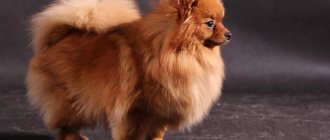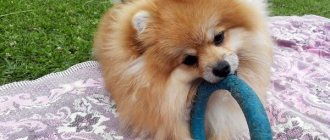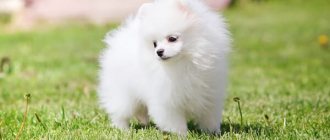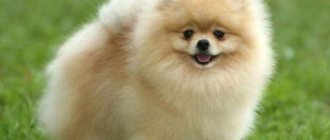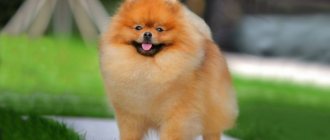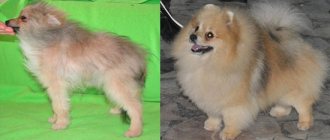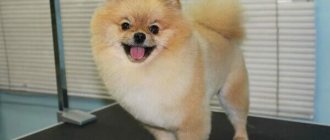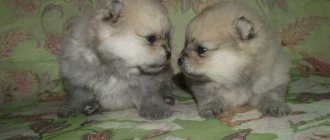A small funny dog that looks like a fluffy bear cub is actually a distant descendant of an ancient canine family that was formed without the participation of breeders. The genome of Spitz-type dogs is closest to that of a wolf, hence the good health, high intelligence, and independent character of the pet. Owners of a Pomeranian often see it only as a toy and spend little time training their dog. This is fundamentally wrong. An ill-mannered dog is a source of problems not only for the owner and his family, but also for everyone around him.
Features of raising a Pomeranian Spitz
Among the ancestors of the Pomeranian Spitz there are excellent hunters, strong sled dogs and reliable guards. The Pomeranian is an ornamental breed, but its psychology and character are inherited from natural leaders, the leaders of the pack. The dog is stubborn, independent and very smart. He is also a cunning manipulator with a sweet little face.
If you raise a baby without proper training, the Pomeranian very quickly assesses the situation and begins to shamelessly take advantage of its privileged position. He loves to stage “performances”, demonstrates resentment, and is capable of throwing a hysteria worse than a tragic actress. And what is an unhappy face worth if the poor dog is not given a tasty morsel?
Loud yelling and corporal punishment will not solve the problem of training a Pomeranian. It is necessary to establish a connection between the animal and the person, to learn to understand the needs of the pet. Persistence and encouragement instead of shouting and punishment will give good results, and most importantly, they will bind the owner and pet into a strong friendship.
How to properly raise a Pomeranian Spitz?
Pomeranians are very playful and cheerful by nature. It's not just little puppies that love to play. Adults are also not averse to taking part in the fun. Training needs to be built on this weakness. Classes are turned into comic competitions, where the prize is a tasty piece and the owner's affection. You shouldn't turn your studies into work. You need to train a Pomeranian Spitz casually, without focusing on what is happening.
boy
Orange Spitz boys are stubborn “leaders of the pack.” They try to dominate everyone who comes into their social circle. And if you can’t subdue someone by force of character, natural acting talent comes into play. The owner does not want to fulfill the “legal” demands of the pet? The petty deceiver immediately becomes sick, unhappy, refuses food, and slowly and sadly leaves these unjust people.
girl
Training a female Pomeranian is a little easier. She does not have the makings of a tyrant like the boy, but her acting abilities and penchant for manipulation are no worse. An affectionate and flexible girl will not insist on her own way, but will achieve everything she wants with the help of a sweet little face and pleading eyes. In extreme cases, hysterics with howling, squealing and whining are used. Moreover, the young lady is capable of hysteria until the owner gives up.
Raising a Spitz by month
Educators and teachers know very well the simple truth: re-teaching is more difficult than teaching from scratch. If you immediately teach your Pomeranian “what is good and what is bad,” then in the future you will be able to avoid many troubles. Typically, regular training begins at the age of 2 months. But if the puppy appears in the house before this time, he will have time to “pick up” bad habits, which he will then have to wean off.
Depending on age, Pomeranians are taught the following skills:
- 1-2 month. Know the situation at home, your place, the purpose of the tray and prohibiting commands. Little by little they learn to get used to their nickname.
- 3-4 month. This is the stage of socialization. Acquaintance with the world continues, but outside the home. The habit of going to the toilet outside is developed. There is a ban on food from someone else's hands.
- 5-6 month. Start of full-time classes. The ability to walk next to the owner, return on demand, stand, sit and lie down on command.
By six months, the Pomeranian needs to be taught basic commands. This is adolescence for a dog with all the ensuing problems: rebellion and ignoring the owner, a test of the strength of the owner’s character.
Training with a dog handler can begin simultaneously with the start of walks on the street, when quarantine ends after the second vaccination.
How to stop biting
Puppies during the period of changing teeth (3-4 months) are looking for something to bite. And, usually, they choose the legs and arms of the owner. But this behavior will become a habit and subsequently will no longer be funny if the Spitz is not weaned from biting at an early age.
First of all, the baby must understand that human body parts are not a toy. Therefore, when the dog wants to bite someone, offer him a ball or a squeaker.
When a puppy bites his fingers not on purpose, but out of interest or boredom, it is better not to pay attention to it, but not to give him a reason to behave this way next time.
There are developed training schemes that help to wean a Spitz from biting.
- When the puppy is calm and well-fed, hold your hand in front of his muzzle. If the baby does not react, he should be praised and treated with a treat. Otherwise, pull your hand back and sternly say: “You can’t!” The training is carried out 2-3 times daily.
- If your Spitz wants to bite, hide your hands behind your back. When he calms down, snap your fingers in front of his nose and give him a treat. Repeat several times.
Is it difficult to train a Pomeranian?
The Pomeranian breed is famous for its intelligence, and these small dogs are usually not difficult to train. The culprit of gaps or defects in upbringing most often becomes the owner himself.
Common mistakes in training:
- Lack of human persistence. The pet instantly “sits on its head” as soon as the owner gives in once.
- Elevation of the little Pomeranian cunning man to the rank of “master of life.” He loves to dominate. The slightest mistake in training, and the whole life of the family revolves only around the furry tyrant.
- Tenderness and delight at the dog’s appearance. A smart manipulator subtly senses the emotions of those around him, understands when he is admired and takes full advantage of this, forcing the owners to “dance to their tune.”
When training, you need to be prepared for insubordination, cunning and hysterics. If the owner’s actions somehow infringe on the pet’s freedom or desires, a gala concert is inevitable. However, high intelligence helps the dog quickly remember commands and correctly assess the “carrot and stick” situation.
At what age can a Pomeranian be trained?
The Pomeranian is ready to start training almost from birth. From the very first minute of acquaintance, the owner must establish rules that cannot be broken. Making allowances for infancy and an immature mind is dangerous; the pet remembers all the concessions from the person and in the future requires the same lenient attitude towards itself.
You can start training by training your puppy to use the litter tray. First, they prepare the place where the dog toilet will be: they remove everything that might interest the pet. A small puppy perceives rugs, carpets and rags as a suitable place to relieve itself. It is better to remove these things until he learns to use the litter box. After eating or sleeping, you need to take the puppy to the litter box and wait for it to do its business.
How to toilet train
Despite the fact that the Spitz dogs taken from the nursery are potty trained, they will still have to deal with this issue in the new place. Follow these rules and you will succeed:
- remove carpets from the floor to avoid damage;
- buy disposable diapers, put them in a certain place and when the puppy tries to go to the toilet, move him to the diaper, praising him if he succeeds;
- in case of “accidents”, do not scold or punish the baby, he must get used to the new rules.
When your pet is used to the diaper, place a tray in this place and put a “used” diaper so that he makes an association with going to the toilet and a new item for this task.
Pomeranian in a diaper
Gradually move the tray closer to the toilet until it is inside.
Where to start training?
Like any science, education requires a systematic approach. Basic rules of training:
- Regularity. You cannot train a Pomeranian spitz from time to time. You need a clear schedule from which you should not deviate. But this does not mean that a Pomeranian child should be forced to work with threats. The owner will have to come up with (find a description in the literature, get advice from a specialist) fun activities where the material is presented in a playful way.
- Repetition is the mother of learning. At the beginning of each lesson, you need to repeat all the completed commands. If the knowledge has not yet been consolidated, you should not give new material.
- Patience. The baby will definitely make mistakes. You can’t react too harshly to them and poke your puppy’s nose into a puddle every time. It is worth showing dissatisfaction, but avoid shouting and anger.
- Alternating rewards and punishments. For every success, even minor success, the pet should be praised and rewarded. And the punishment for wrongdoing should not be excessive.
- The right time and place. Training will give results if the puppy does not become distracted by the environment, people or other animals. On the street you need to find a separate place where there are no objects of interest to the baby. You should not train in the house with a large crowd of people.
The owner's dissatisfaction should be caused by aggression towards other animals, “empty” barking, and the desire to dominate. You should start with the simplest commands and do not move on until the material is mastered. Pomeranians, like all animals, are very susceptible to human intonations and emotions. Prohibitory commands (“Ugh!”, “You can’t!”) are given in a stern voice, and the rest must be pronounced confidently, but not aggressively.
The Pomeranian should not be allowed to carry out commands voiced by a stranger.
Training at 3 months. Socialization
Three months is an important stage in a Pomeranian puppy’s introduction to the outside world. Your first walks should be short and not too tiring for the puppy. You should start with 15 minutes, gradually increasing the walking time to 1 hour.
Correct formation of the nervous system
At this age, the puppy’s nervous system is forming.
. It has been proven that raising puppies in isolation during this important period contributed to the development of pronounced cowardice in them later. It is necessary to show the puppy as much as possible: noisy streets, large crowds of people, etc. Everything that he will have to face in later life.
What can you teach a Pomeranian?
It is worth starting training with the basic commands. You cannot teach a bear, fox, or toy Pomeranian to sit or run next to its owner before the puppy has mastered the basics well.
Knowledge and skills developed through proper training.
| Basic Commands | Characteristics of the actions of the owner and the dog |
| "Name" | The puppy must remember its name and respond to it unquestioningly. You should not choose an intricate long name for your pet, so as not to complicate training. |
| "Ugh!" | This is not a cry of disgust, but a warning of danger. When a puppy shows attention to something dangerous (object, food, situation), you need to give a command in a stern voice with clear articulation. In addition, you can slightly tighten the leash (do not pull too hard). |
| "It is forbidden" | This is not the same as “Ugh!” The command means that the dog must stop the action that is happening at the moment (barking for no reason, begging, trying to dominate, etc.). The command must be given in a confident tone that does not allow for objections. |
| "Place" | The puppy must know where this very place is. Before training, you need to arrange for him to lie down. The first time the command is performed by the owner himself (pick up the pet, carry it to its place and be sure to praise it). |
| "To me" | The command is pronounced confidently, kindly, and is accompanied by a slight pull on the leash. When reinforcement with a leash is no longer required, you need to praise the puppy especially actively. |
| "Sit" | This is an intermediate option between simple and complex commands, the beginning of raising a truly disciplined dog. The dog should stand at the owner's side on a short leash. Then they pronounce the puppy’s name and confidently give the command, while lightly pressing the dog’s sacrum. Use a leash to slightly lift the front part of the body. When the Pomeranian follows the command, he is sure to be praised and rewarded. |
Command "Near!" - this is the next level, allowing the owner and dog to feel confident in any crowd of people. The dog should stand close to the person’s left leg (pull it slightly with a leash). When moving, the puppy may change direction or speed. The owner carefully corrects the behavior with the help of a leash. Every success is sure to be rewarded.
Training at 4 - 5 months
By this time, the Pomeranian Spitz puppy has already become accustomed to your home and usual walking areas, and no longer needs your support and care so much. He begins to flirt with other dogs, pretend that he does not hear you when you call him, and show a certain persistence and disobedience when performing various commands.
This means it's time to move on to full training . In classes at this age you can already be persistent and demanding. At the same time, the most important thing is not to overdo it, remember that classes should bring joy to both you and your dog, and only then you can achieve the desired result.
Required commands in 4 months
What commands are practiced by a Pomeranian Spitz puppy at 4 months:
- Calm movement next
to the owner with and without a leash, with landing when stopping, with a change in pace and direction of movement - Return to you
on command - Exposure
in a free or certain position (sitting, lying, standing) - Indifferent attitude towards treats scattered on the ground
- Inhibitory command
to stop unwanted actions - Execution of a set of commands “sit”, “lie down”, “stand”
at a distance and near the leg, when giving commands by voice and gestures - Stop barking
on command.
Types of dog training
Mandatory skills that a pet must acquire as a result of training:
- basic command training;
- friendly communication with others (without barking, dominance or aggression).
Dogs can be trained in different ways:
- independent studies;
- training under the guidance of a dog handler;
- joint training (owner + dog + dog handler).
Each of the schemes has pros and cons. Training an energetic and confident dog requires patience, sometimes almost angelic, and firmness. If the owner of a dog of the Dwarf Spitz breed has these qualities, then you can do the training yourself. But to be on the safe side, it wouldn’t hurt to contact a dog handler, at least at first.
Classes with a dog handler
Only the puppy and the specialist participate in the training process. The owner receives an obedient, well-mannered dog. The advantages of the scheme are that the dog handler will not only teach the pet basic commands, but also prepare it for exhibitions. Disadvantages of the method: the owner will be separated from his pet for a long time. When the “prodigal dog” returns to the house, both the owner and the dog will have to get used to each other again. In addition, it is quite expensive to train a Pomeranian from a qualified dog handler.
Lessons with the owner
The most difficult, but most effective option. If the owner can become a mentor-guru for the Pomeranian Spitz, then in the future you can train the dog without any problems. The Pomeranian recognizes the person as the “leader of the pack”, learns to respect him and obey him unquestioningly. There is only one drawback to the training scheme, but it is very significant: complete dedication is required. You will have to read a mountain of specialized literature, be patient and have time.
Joint training at the dog training center
Joint training takes place at the canine center under the guidance of professionals. Training, which involves the owner, the Pomeranian and a dog handler, is a reliable and informative option. The owner gains invaluable training experience. The pet learns not only basic commands, but also how to interact with other animals and people. The main advantage of joint training is that the owner and the dog do not have to be separated and then get used to each other again. Their connection will only strengthen during classes.
Types of training
You can teach a German Spitz basic commands using 3 training methods:
- Cynological. Suitable for beginner dog lovers. The pet is sent to a training school, where professionals work with it. Result 100%. Disadvantages: separation for 2-4 weeks, lack of relationship with the owner.
- Joint. The owner works with a German Spitz under the supervision of an instructor. The most reliable method. In addition, classes will be more necessary for a person than for a dog - he needs to learn how to interact correctly with a pet, understand him and speak the same language with him.
- Independent. Training a Spitz at home is not difficult, even if you have no experience. The main thing is to study thematic literature and videos. Plus – free training, building close relationships. And if something doesn’t work out, you can always contact a dog handler.
With any type of training, the dog can be taught using three different approaches to training:
- incentive - the pet is treated or praised after correctly following orders;
- mechanical: the owner helps the dog carry out the command - he presses on the withers, croup, pulls the leash, pulls it away with his hand, this way you can start the first training;
- contrasting - both methods of training are used.
Any training method is good. But it is better to resort to contrast - the German Spitz quickly learns commands that are simultaneously reinforced by physical influence and praise.
How to teach your Pomeranian commands and tricks yourself?
First of all, a small Spitz puppy should be taught prohibitive commands, and only then can you proceed with the rest. Two main prohibitions: “Ugh!” and "You can't." They are trained with food or toys. You need to place a tasty morsel or ball close to the dog or hold it in your hand. This is followed by a prohibition command. Reward is given only after the pet stops reaching for food or a toy.
Pomeranian Spitz training:
- The “Give” command is taught using something. When a pet approaches its owner with a toy in its mouth, a command follows and the person carefully removes (does not pull!) the object from its mouth.
- The order “Come to me” is taught through food. The owner holds the piece in his hand, pronounces the command and rewards the pet after it is completed.
- The “Place” command is first performed by the owner instead of the pet. The puppy is picked up and carried to the bed, repeating the command. If the dog remains on the bedding, he is rewarded.
- “Voice” is the easiest command for a “talkative” dog. The owner raises the treat higher, but does not give it to the puppy until it barks.
It is better to learn complex commands under the supervision of a dog handler, especially if the owner is a novice dog breeder.
Features of training a Pomeranian Spitz at home
The main rule of training is to establish a hierarchy. The pet must understand “who’s boss.” This can be achieved as follows:
- feed the dog only after the owners have eaten;
- the person goes through the door first;
- during a walk, the Pomeranian Spitz walks slightly behind the owner and does not rush far ahead;
- establish a strict ban on eating from the master's table and being on the bed;
- the beginning and end of classes or games is set by a person;
- any aggression is stopped immediately and firmly.
A daily routine will help your Pomeranian consolidate the skills and habits it has developed. A combination of physical influence (lightly press on the croup, pull the leash, guide with your hand) and encouragement will help teach the correct execution of commands.
Spitz temperament
The Spitz is a beautiful, emotional and very cheerful dog that people fall in love with at first sight. A charming pet quickly realizes that it has become the object of everyone's sympathy, and knows how to take advantage of it. The habit of hooliganism and demonstrating inappropriate behavior (for example, begging for pieces from the table) can result in considerable problems in the future when an adult dog begins to behave as he pleases. To prevent this from happening, you should train your dog from the first day it appears in the house.
A Spitz can become a real tyrant in a family if it is not raised correctly.
It is important to consider that Pomeranians:
- prone to dominant behavior, although small in stature;
- natural guards, despite their good looks and cheerful disposition;
- They respond well to training, as they are smart and try to please their beloved owner in everything.
How to play with a Pomeranian at home?
Pomeranians are playful by nature, and a well-trained pet also clearly understands when to play and when to leave the owner alone. Lesson options:
- wrap a tasty piece in a napkin or handkerchief and invite the dog to get it himself;
- hide the food in a drawer in front of the dog, close it loosely and allow the dog to get a piece;
- tie a piece of fairly dense food (for example, a pig's ear) to a long string and push it far under the furniture, inviting the dog to pull the food out by the rope;
- leave the pet alone in the room, close the door loosely and call the dog (he must cope with the obstacle on his own).
You can train your Pomeranian to jump through a hoop or jump rope, overcome a “scary” tunnel made of a blanket on stools, or fetch a toy.
Tips for care and training
A well-bred Pomeranian Spitz will not cause big problems in its maintenance. Caring for your pet consists of regular brushing, brushing teeth and ears, trimming nails and bathing. It is better to entrust monitoring of the condition of teeth to a veterinarian. Brushing can be turned into a kind of ritual, at the end of which the dog receives encouragement. You can trim the nails yourself, but for the first time it is better to watch a professional work. Bathing your Pomeranian completely is not recommended, especially during shedding. The maximum “water procedures” is washing your paws after a walk.
In some cases, care and training can be combined. For example, when a dog first arrives in the house, you can spread several diapers around the dog's toilet. As soon as the puppy goes to one of them, it is transferred to the tray and left until the next time. If he again goes somewhere to the side, a new soiled diaper is transferred to the tray. The number of diapers is gradually reduced, removing those that remain clean.
The main commandment of training is the same law for everyone and for all times. You cannot indulge your pet, even if he is sick. Proper upbringing shapes character:
- a trained dog follows the command the first time;
- the dog must know that the owner will stroke and praise him only for good behavior;
- At the beginning of training, the Pomeranian Spitz should be addressed only by name, no “babies”, “fluffies” or other words that the dog does not understand.
Cruelty, constant yelling and scolding are a bad choice. They begin to teach with the simplest concepts and gradually increase the complexity of the tasks. Ideal conditions are required (no irritating or distracting factors). All commands are pronounced in a confident tone that does not allow for objections.
Tips from dog handlers
If you choose independent training, dog trainers recommend adhering to the following tips:
- Consider the dog's character. All animals are unique and each of them requires a special training program, adjusted to a specific character.
- Seek professional help if you have difficulties. Don't be afraid to communicate with kennel club staff. They will definitely help in solving any problems, because this is what their main work is based on.
- Never make exceptions and avoid provocations. One mistake and the Spitz, feeling like a full-fledged authority, will begin to twist the rope out of the owner.
- Don't forget the importance of walking. Long walks are the key to keeping the little Energizer calm.
Once you become the owner of a little bundle of happiness, try to follow these recommendations. Remember that the specifics of training depend entirely on the character of the particular animal. You can’t put all dogs under the same brush, because they are all unique.
Training your pet on your own has the right to life and allows you to achieve maximum mutual understanding with your four-legged friend. Do your best and raise a pet that you can be truly proud of.
Useful skills and commands
The most important skills to teach your puppy first are knowing his name and getting used to the toilet. It is useful to show your Pomeranian the difference between the “Voice!” commands. and “Quiet!” If the dog starts barking loudly, the owner gives the command “Voice!”, and then carefully covers his mouth with his hand and gives the command “Quiet!” Success is definitely rewarded. In addition, the following commands can be included in Pomeranian training: “Give me a paw”, “Fetch”, “Bow”.
Toilet training
When a puppy first comes into the house, he is surrounded by strange, frightening smells. A tray with a diaper, on which even a faint trace of the dog’s urine or feces remains, will be the first place with a familiar smell. The baby is immediately placed in a tray covered with a diaper and is not released until he relieves himself. “Victory” is rewarded with affection and encouragement, and then you can let him go and get acquainted with the situation.
If your pet has ever stepped on the carpet, he will repeat it again and again.
Nickname
The Pomeranian Spitz perceives a short, sonorous name more easily and remembers it faster. The pet's name should be pronounced affectionately, in a calm voice. Every time there is at least some kind of reaction (the puppy turned its head, looked, made a movement towards the owner), it needs to be reinforced with encouragement. Food reinforces the skill well. If, after pronouncing the nickname, the dog runs up to the owner, he should receive a tasty piece. Before feeding, you need to call the puppy, attracting his attention, and only then put the bowl on the floor.
Alone at home
When a beloved owner leaves home, the puppy may decide that this is forever and “cry” from fear and loneliness. This moment will have to be endured. You can’t go back and console the baby. Over time, he will understand that the owner will definitely return. Also, you should not react to a pet’s whining if the person has gone into another room or is not paying attention to it. Once the Pomeranian understands that whining is a reliable way to attract the owner, he will shamelessly manipulate it. Toys, special edible bones and balls will help protect your home environment from the consequences of interacting with a curious and mischievous puppy.
Weaning off barking
If loud barking is caused by an objective reason (the dog feels danger, is scared or alarmed by something), you cannot punish it. A negative reaction is only needed in cases where the pet voices for no reason. The only way to wean him off “empty” barking is to distract attention with a loud sound, call him to you or give any familiar command, and then say in a firm voice: “Quiet!” You cannot shout or scold your pet loudly. This causes anxiety and confusion, and the animal may think that the owner is also barking. When the dog follows the command, he must receive a reward.
Character traits
Raising an obedient pet will be impossible if you do not understand its psychological characteristics. It must be remembered that a Spitz will never think like a person, will not be able to build complex logical chains, and acts based on reflexes and primitive instincts. On this basis, a small Spitz should be raised, developing its natural qualities, building the right associations.
The Pomeranian is an open, intelligent, resourceful dog, able to instantly learn a command in order to please his beloved owner. Even a beginner can cope with the training process, but with the slightest failure, education can stop at some stage. A baby can turn into a real tyrant, and the reasons for problematic Spitz training at home lie in the negative aspects of his character. The pet is so stubborn that it can stand its ground even under the threat of punishment, and the dog can obey, realizing that the owner is also stubborn.
If you train a baby incorrectly, he may imagine himself as an authority, doing everything to ensure that the owners fulfill his wishes.
These are manipulative dogs and empaths, capable of feeling human emotions and taking advantage of their beauty. Spitz are distinguished by their artistry and can evoke pity or guilt with the help of a whole arsenal:
- grimaces of sadness or requests;
- insults or leaving for another room;
- reluctance to communicate with the owner;
- barking or howling;
- hysterical squealing during verbal punishments or infringement of their freedom with a leash.
A peculiarity of behavior can be called excessive playfulness of puppies and older individuals. The character of males is stubborn, and that of females is flexible and tender.
What to do if your Spitz doesn't listen?
Before punishing your Pomeranian, you need to find out the reason for the bad behavior. Perhaps the dog is afraid of something or is accustomed to permissiveness. If your dog has been obedient all along but suddenly changes, it may be sick or very tired.
Punishment is the same part of training as encouragement, but you need to point out your pet’s mistakes correctly:
- Punishment must always be deserved. You can’t take your bad mood out on a dog that turns up at the wrong time.
- Punishment must be made at the time the offense is committed or immediately after it. If some time has passed since the “crime,” the animal will not understand why the owner is dissatisfied.
- Prohibitions are the law for the dog and the owner. For example, if it is forbidden to take food from someone else's hands, the owner should not allow or provoke such a situation.
- Lack of encouragement is also a punishment. Affection needs to be dosed.
- Ignoring the owner must be punished immediately. This may be a stern shout, a threatening tone, but you cannot hit your pet, especially with your hand.
The owner's hand is what strokes and caresses. If corporal punishment is really necessary, you can take a rolled up newspaper, a towel or a thin twig.
